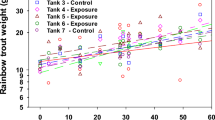Abstract
The influence of diet properties and feeding rate on the uptake and elimination of polychlorinated biphenyls (PCBs) was investigated in ring doves (Streptopelia rissoria). Elimination rates of PCBs were determined in birds dosed with an Aroclor mixture (1242:1248:1260, 1:1:1) and allowed to depurate on uncontaminated high-lipid or low-lipid/high-fiber diets for 105 days. Uptake rates for seven additional PCBs not found within the above Aroclor mixtures were studied in the same birds by feeding high- or low-lipid PCB-spiked diets for 15 days. The two diet treatments contributed to differences in feeding rates, fecal egestion rates, and total fat volume of the birds. Uptake rate constants of PCBs were higher for the low-lipid diet group, whereas PCB assimilation efficiencies were similar between the two groups. Whole-body elimination rates of Aroclor PCBs were most strongly influenced by the chlorine substitution pattern of the congeners, such that PCBs containing an open meta-para site on one of the phenyl rings were rapidly cleared from the animal. Whole-body elimination rates for persistent PCBs could only be determined for PCB 28; other congeners exhibited negligible elimination over the depuration period. For the latter compounds, fecal elimination rates were estimated using the excreta/carcass distribution coefficient and excreta production rates. For PCB 28, the fecal elimination rate was similar to the whole-body elimination rate, suggesting that fecal elimination of persistent PCBs dominates whole body elimination of these compounds. Diet treatment effects were less evident for PCB elimination rates compared to uptake rates. Steady-state biomagnification factors were estimated to range from 1.0 to 5.1 for rapidly cleared PCBs and from 27 to 97 for persistent congeners.
Similar content being viewed by others
Author information
Authors and Affiliations
Additional information
Received: 11 October 2001/Accepted: 30 May 2002
Rights and permissions
About this article
Cite this article
Drouillard, K., Norstrom, R. The Influence of Diet Properties and Feeding Rates on PCB Toxicokinetics in the Ring Dove. Arch. Environ. Contam. Toxicol. 44, 0097–0106 (2003). https://doi.org/10.1007/s00244-002-1199-y
Issue Date:
DOI: https://doi.org/10.1007/s00244-002-1199-y




